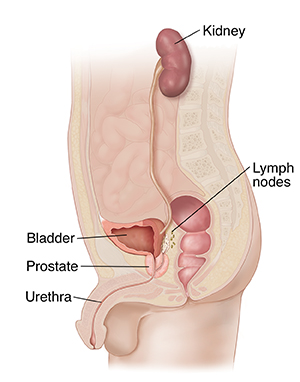Cystectomy
Cystectomy
Cystectomy is surgery to remove the urinary bladder. It may be done in certain cases of bladder cancer. Your doctor can discuss the risks and benefits of the surgery with you.
|
Preparing for surgery
You’ll be told how to prepare for surgery. These instructions may include:
Donating your own blood a few days before the surgery. This is in case you need a transfusion during the surgery.
Taking antibiotics before surgery. This is to help prevent infection.
Not eating or drinking anything a certain amount of time before surgery.
Clearing your intestine. You may do this by drinking a special liquid at home. Or you may be admitted to the hospital the night before surgery and given medicine and enemas to empty the intestine.
Removing the bladder
The surgery is done in a hospital. It takes about 4 to 6 hours. Just before surgery, you’ll be given medicine called general anesthesia to prevent pain. This puts you into a state like deep sleep during the surgery. An incision is then made near your bellybutton. This exposes the bladder. The area around your bladder is examined to see if the cancer has spread. If it has, the surgery may not be continued. If the cancer is only in the bladder, the bladder is removed. Other organs near the bladder may be removed as well. This is in case cancer cells may have spread to those organs.
Creating a new path for urine
After the bladder is removed, you will need a new way to store and release urine. There are 3 different options to accomplish this task. Talk to your healthcare provider about which option would be best for you. The options include:
Incontinent diversion: A short piece of intestine is removed and connected to the ureters while the other end is connected to the skin on the front of the abdomen forming an opening called a stoma. This procedure is called a urostomy. A small bag is placed over the stoma to collect the urine.
Continent diversion: A valve is created in a pouch made from a piece of intestine. You can empty the pouch several times a day by inserting a drainage tube (catheter) into the stoma through the valve. This method does not require a collection bag.
Neobladder: A new bladder is created from a piece of intestine and urine is routed back into the urethra, restoring urination. Over time most people are able return to normal urination during the day but many may still have incontinence at night.
Risks and possible complications
Infection
Bleeding that requires a transfusion
Blockage of intestine
Inability to have an erection or trouble having intercourse
Blood clot in the veins because of physical inactivity
Updated:
August 04, 2018
Reviewed By:
Goode, Paula, RN, BSN, MSN,Greenstein, Marc, DO,Image reviewed by StayWell medical illustration team.

